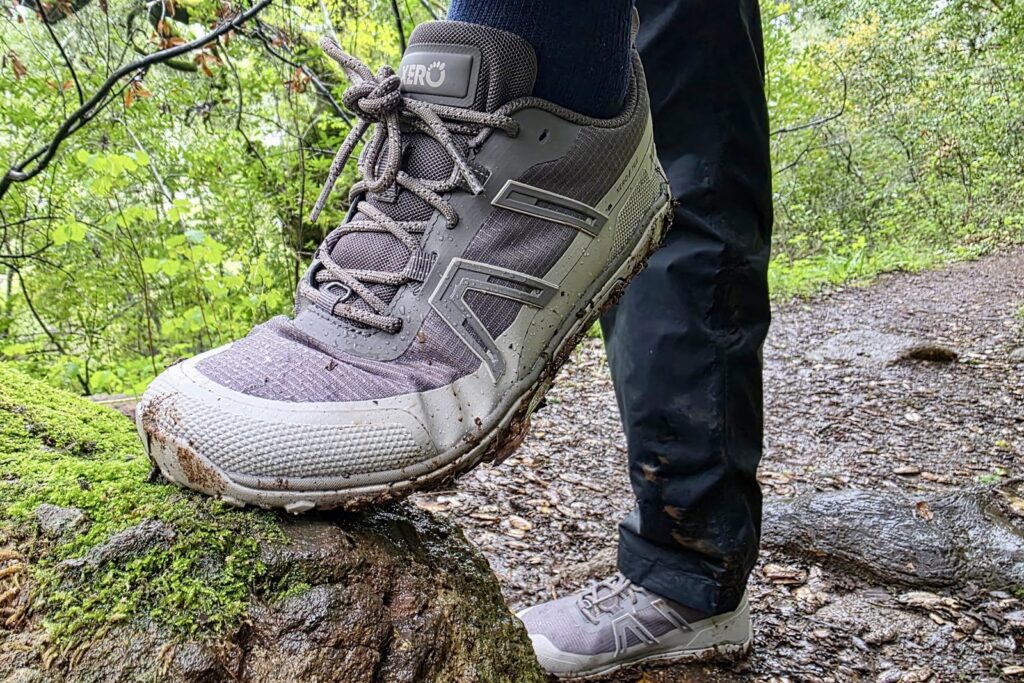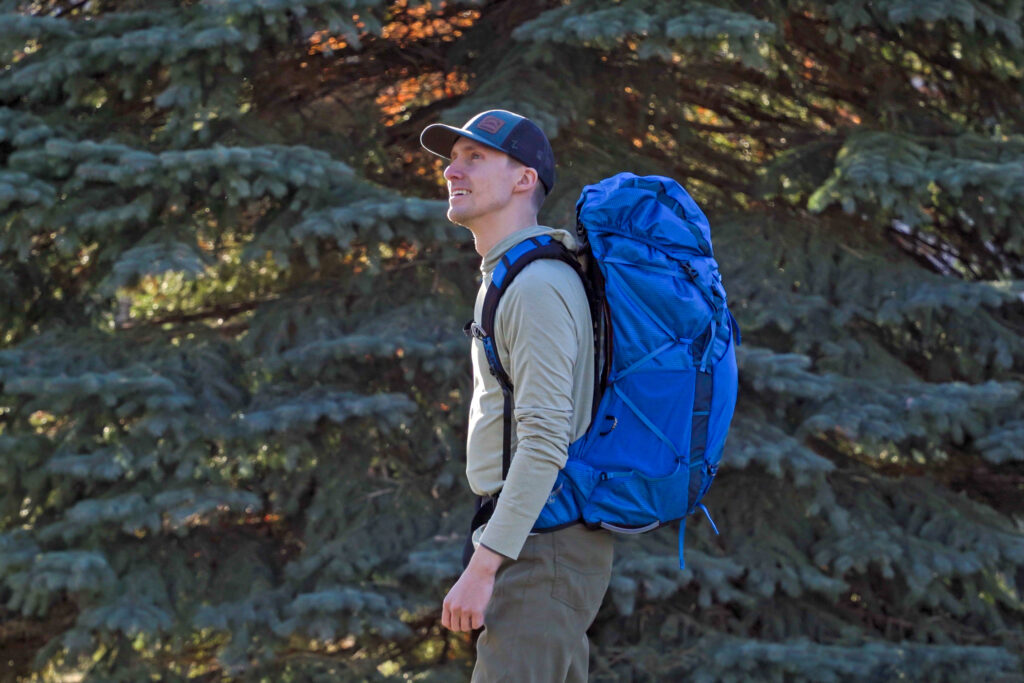
Bottom Line
For stomach and back sleepers who want lightweight comfort on the trail, the Sea to Summit Ultralight Insulated is a solid choice. It earns a spot in our Best Backpacking Sleeping Pads Guide as an affordable and cozy sleeping pad. CleverHiker founder, Dave Collins, put it to the test, logging 15 chilly, damp nights and over 250 miles in Oregon’s rugged Mount Hood and Gifford-Pinchot National Forests. He also tackled 10 nights in the scorching southern Utah desert, exploring Buckskin Gulch and Paria Canyon.
The Ultralight Insulated’s 2-inch thickness and quilted pattern offer even weight distribution and a comfy surface. It’s also pretty lightweight and provides decent insulation for its price. Its valve system is simple, efficient, and effective. Inflation is fast with the included pump sack – which doubles as the pad’s stuff sack – and the durable ripstop nylon holds up well against wear and tear.
Side sleepers might struggle with this pad’s thinner profile, as it’s possible to bottom out when shifting around at night. The valve’s placement on top of the pad is also a bit awkward, as you may feel it while you sleep, and the pad has a slightly rubbery texture, which some may find uncomfortable.
While the Sea to Summit Ultralight Insulated didn’t make it to the tippy top of our backpacking sleeping pad list, it’s still a comfortable, well-rounded pad at a good price..
Quick Specs

Sea to Summit Ultralight Insulated
Best Value Sleeping Pad for Back Sleepers
CleverHiker Rating: 67.3/100
Price: $169
Weight: 1 lb. 0.9 oz.
R-Value: 3.1
Thickness: 2 in.
Pros
- Lightweight
- Comfortable for back-sleepers
- Less expensive
- Above-average durability
- Quick inflation/deflation
- Excellent valve design for micro-adjustments
- Wider than most pads
Cons
- Can bottom out when shifting around
- Slightly rubbery feel/sound
- Heavier than some
- Valve location isn't ideal

Comfort
The Sea to Summit Ultralight Insulated is a very comfortable choice for back and stomach sleepers thanks to its cushy “air sprung cells”. This pad is 21.5 inches wide(an inch and a half wider than most competitors), so you’ll also have a bit more room to spread out. The quilted design distributes body weight evenly and mimics the feel of your mattress at home, providing a cozy sleeping experience.
The Sea to Summit pillow lock system is also a unique and handy feature. Hook-and-loop patches can be attached to the pad to keep your Sea to Summit pillow (sold separately) from sliding away at night.
But at two inches thick, the Ultralight Insulated is one of the thinnest pads on our Sleeping Pad Guide. This pad provides solid support for folks who sleep on their back or stomach, but it’s a bit thin for side sleepers and hikers who toss and turn a lot in the night. The main issue is that if the pad isn’t inflated firmly enough, you’ll bottom out and feel the ground beneath the pad while shifting around.
We’ve also found the 30D nylon fabric has a slightly rubbery feel and occasional squeaky sound that might not be a great fit for everyone. Still, for its price, weight, and ease of use, the S2S Ultralight Insulated is a pretty comfy pad overall.

Weight & Packability
The Sea to Summit Ultralight Insulated pad strikes a solid balance between weight and durability. At 1 pound, 0.9 ounces, it’s light enough to carry on backcountry treks without feeling burdensome.
Despite its wider measurements, this pad packs down nicely to 4 x 9 inches, saving you space in your pack. The pad’s combined 40D ripstop nylon on the bottom and 30-denier on top is key to keeping its bulk down and its portability up since this material is easy to roll, fold, and pack.
The single-valve design is effective for fast inflation and deflation. Plus, the Sea to Summit stuff sack doubles as a pump sack to trim down your gear list and reduce weight even more.
However, if you want to minimize your sleeping pad weight, there are lighter options on the market. And some of the lighter pads are even thicker and warmer but tend to cost more. For an insulated sleeping pad in this price range, the Ultralight Insulated is pretty light and packable.

Warmth
The Sea to Summit Ultralight Insulated performs well in moderate weather, making it a solid option from late spring until early fall. This pad has an R-value of 3.1, so it’s great for summer backpacking trips and still has enough insulation for shoulder season temps down to around 35°F. Paired with a warm quilt or quality sleeping bag, the Ultralight insulated will keep you warm for the most common times hikers sleep in the backcountry.
However, this model isn’t sufficient for very cold conditions, especially when temperatures drop below freezing. We don’t recommend this pad in winter or high-altitude environments where falling temps can zap your heat. This pad also might not be the best choice for hikers who consider themselves cold sleepers. For those types of backpackers and conditions, we’d recommend choosing one of our more insulated pad recommendations.

Ease of Setup
The Sea to Summit Ultralight Insulated pad has efficient materials, a smart valve design, and an integrated stuff sack pump sack. The nylon material is easy to pack and unpack. The single-valve design has a one-way valve for speedy inflation that can also be pulled to create a dump valve for quick deflation. We really liked this ingenuity when time and energy were in short supply.
We also like the fine-tune button on the one-way valve that allows you to release tiny amounts of air for easy adjustments while lying down. This helps us find the perfect firmness for our comfort and sleeping style.
The pad folds down easily into a compact, manageable size, and the oversized stuff sack means there’s no wrestling to fit the pad back in. Unlike competitive pads with separate stuff and pump sacks, the Ultralight Insulated combines the two to save a little weight. To use it, simply turn the stuff sack inside out, connect the nozzle to the pad, and in only 5-6 breaths, you’ll be ready to lay down.

Durability
The Sea to Summit Ultralight Insulated pad is built to last. It has a 40-denier ripstop nylon bottom layer that’s thicker and tougher than many backpacking pads on the market. That, paired with a 30-denier top layer, strikes a good balance between strength and weight.
Our testing found this pad was more resistant to abrasion and punctures than many other pads in its price and weight range. This is a solid option if you’re looking for a sleeping pad that can handle nights on rocky or rough surfaces and perform through multiple seasons of backpacking.

Should You Buy the Sea to Summit Ultralight Insulated?
The Sea to Summit Ultralight Insulated is a good choice for back and stomach sleepers who prioritize a balance between weight, comfort, and durability at a reasonable price.
It has a reasonable weight and packs down small, making it a solid choice for three-season backpacking trips. Its extra width and air sprung cells offer mattress-like comfort, and the valve design is good for dialing in the perfect firmness. With an R-value of 3.1, it’s warm enough for late spring to early fall, and its durable build makes it a long-lasting investment for years of backpacking.
However, this pad could benefit from a couple of changes in a few key areas. Side sleepers may find its 2-inch thickness a bit lacking, as it may bottom out when you’re shifting positions. The slightly rubbery texture and noise can also be a bit off-putting to some. It’s also not among the lighter or warmer sleeping pads we tested, which makes it unideal for ultralight backpacking and chilly trips.
Those hangups might not apply if you’re not picky about fabrics, you’re not planning on winter/cold backpacking, and you sleep on your back. The Sea to Summit Ultralight Insulated provides a happy balance between comfort, weight, durability, ease of use, and price.

What Other Backpacking Pads Should You Consider?
Want to test some other options? Or list of the Best Backpacking Sleeping Pads has recommendations for all styles of sleepers and trips.
NEMO Tensor Trail Ultralight Review: The Tensor Trail is only a bit more expensive than the Ultralight Insulated and offers a similar R-value, but it weighs quite a bit less and offers 1.5 more inches of thickness. This improved comfort is better for side sleepers and longer summer treks where every ounce matters. We also highly recommend the Tensor All-Season if you want a much warmer pad for only a bit more weight.
Big Agnes Rapide SL Insulated Review: The Rapide SL is more affordable than the Ultralight Insulated – but it’s also much warmer, thicker, and packs down smaller. It does weigh about an ounce more, but that’s not too bad for an upgrade to all those other important areas.
Sea to Summit Ether Light XT Review: The Ether Light XT is twice as thick as the Ultralight Insulated, making it a more comfortable option for uneven ground and side sleepers. It offers similar warmth, ease of use, weight, and durability but is more expensive.














